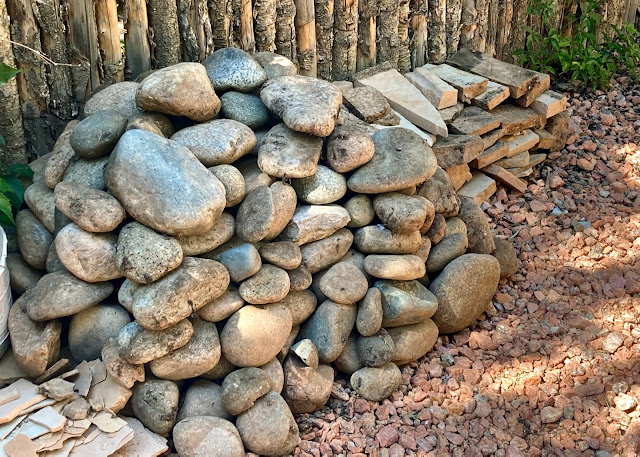Rock Piles
This stack of melon sized white rocks is what I have removed from around the trees here.
Unlike my New England gardens where rocks from the last ice age studded every inch of soil, these big round rocks were landscaping additions, purchased and installed in circles around the shrubs and trees.
Mostly the rocks were there to capture and hold any rain at the base of new tree plantings. But I think originally they were a design aesthetic too, a kind of decorative attempt maybe.
The two aspens in back sat in stone circles when we first moved in. As I created new gardens, I picked up the stones and stacked them in a pile behind the house.
The Spanish broom and the Chinese privet nearby each sat in a lumpy collar of rocks.
When we had additional pea gravel added to the back yard to refresh bare spots, it ended up burying the ring somewhat. So I left those in place; they weren't quite so obvious tucked into the gravel.
But recently I decided to take them out. I started with the privet next to the Spanish broom, picking up the surface level rocks from underneath it, and then prying out some below that, and then discovering that the ring of rocks kept going, deeper and deeper. I kept prying out more and more, further and further down.
Embedded far down in the soil and tightly ringing the narrow stems of the shrub were dozens and dozens of these big stones.
With all the rocks removed, the privet is now sitting in an open pit, well below the surface of the surrounding yard. I have to do something about that.
I can't imagine how it grew in a pile of rocks for 20 some years. Half of this piled stack came from removing rocks around the aspens, but the other half is simply what the Chinese privet was growing in -- a well of rocks.
I haven't even started on what surrounds the Spanish broom yet. I need to get more Advil before I tackle that.





Comments
how invasive is Chinese privet? that deep well was certainly intentional. Yes? or maybe the stones wouldn't keep privet roots sequestered?
Have you read Finding the Mother Tree by Simard? it is our discussion book this afternoon. I thought it a tour de force.
I will check out the Simard book. Other than that book about caves, I trust your recommendations!